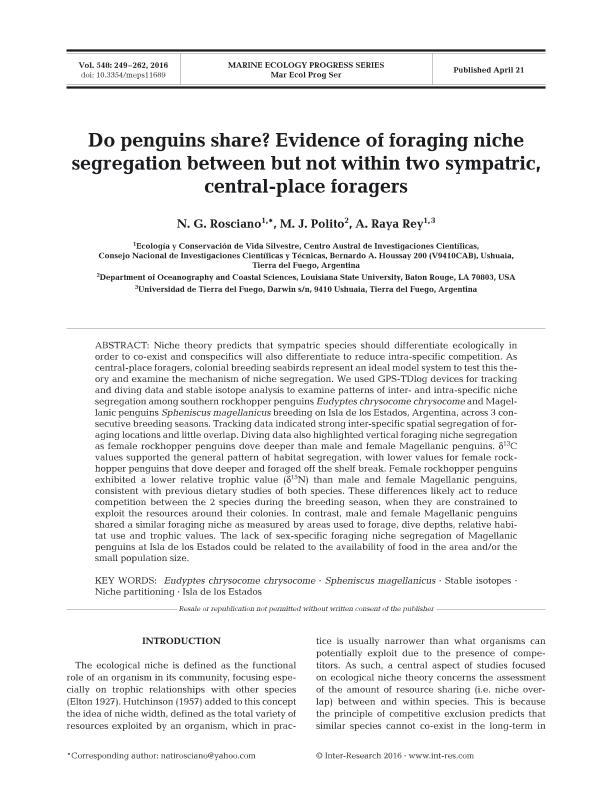Mostrar el registro sencillo del ítem
dc.contributor.author
Rosciano, Natalia Gimena

dc.contributor.author
Polito, Michael J
dc.contributor.author
Raya Rey, Andrea Nélida

dc.date.available
2020-01-14T21:11:50Z
dc.date.issued
2016-04
dc.identifier.citation
Rosciano, Natalia Gimena; Polito, Michael J; Raya Rey, Andrea Nélida; Do penguins share? Evidence of foraging niche segregation between but not within two sympatric, central-place foragers; Inter-Research; Marine Ecology Progress Series; 548; 4-2016; 249-262
dc.identifier.issn
0171-8630
dc.identifier.uri
http://hdl.handle.net/11336/94715
dc.description.abstract
Niche theory predicts that sympatric species should differentiate ecologically in order to co-exist and conspecifics will also differentiate to reduce intra-specific competition. As central-place foragers, colonial breeding seabirds represent an ideal model system to test this theory and examine the mechanism of niche segregation. We used GPS-TDlog devices for tracking and diving data and stable isotope analysis to examine patterns of inter- and intra-specific niche segregation among southern rockhopper penguins Eudyptes chrysocome chrysocome and Magellanic penguins Spheniscus magellanicus breeding on Isla de los Estados, Argentina, across 3 consecutive breeding seasons. Tracking data indicated strong inter-specific spatial segregation of foraging locations and little overlap. Diving data also highlighted vertical foraging niche segregation as female rockhopper penguins dove deeper than male and female Magellanic penguins. δ13C values supported the general pattern of habitat segregation, with lower values for female rock-hopper penguins that dove deeper and foraged off the shelf break. Female rockhopper penguins exhibited a lower relative trophic value (δ15N) than male and female Magellanic penguins, consistent with previous dietary studies of both species. These differences likely act to reduce competition between the 2 species during the breeding season, when they are constrained to exploit the resources around their colonies. In contrast, male and female Magellanic penguins shared a similar foraging niche as measured by areas used to forage, dive depths, relative habitat use and trophic values. The lack of sex-specific foraging niche segregation of Magellanic penguins at Isla de los Estados could be related to the availability of food in the area and/or the small population size.
dc.format
application/pdf
dc.language.iso
eng
dc.publisher
Inter-Research

dc.rights
info:eu-repo/semantics/openAccess
dc.rights.uri
https://creativecommons.org/licenses/by-nc-sa/2.5/ar/
dc.subject
EUDYPTES CHRYSOCOME CHRYSOCOME
dc.subject
ISLA DE LOS ESTADOS
dc.subject
NICHE PARTITIONING
dc.subject
SPHENISCUS MAGELLANICUS
dc.subject
STABLE ISOTOPES
dc.subject.classification
Ecología

dc.subject.classification
Ciencias Biológicas

dc.subject.classification
CIENCIAS NATURALES Y EXACTAS

dc.title
Do penguins share? Evidence of foraging niche segregation between but not within two sympatric, central-place foragers
dc.type
info:eu-repo/semantics/article
dc.type
info:ar-repo/semantics/artículo
dc.type
info:eu-repo/semantics/publishedVersion
dc.date.updated
2020-01-13T14:22:29Z
dc.journal.volume
548
dc.journal.pagination
249-262
dc.journal.pais
Alemania

dc.journal.ciudad
Oldendorf/Luhe
dc.description.fil
Fil: Rosciano, Natalia Gimena. Consejo Nacional de Investigaciones Científicas y Técnicas. Centro Austral de Investigaciones Científicas; Argentina
dc.description.fil
Fil: Polito, Michael J. Lousiana State University; Estados Unidos
dc.description.fil
Fil: Raya Rey, Andrea Nélida. Universidad Nacional de Tierra del Fuego; Argentina. Consejo Nacional de Investigaciones Científicas y Técnicas. Centro Austral de Investigaciones Científicas; Argentina
dc.journal.title
Marine Ecology Progress Series

dc.relation.alternativeid
info:eu-repo/semantics/altIdentifier/url/https://www.int-res.com/abstracts/meps/v548/p249-262/
dc.relation.alternativeid
info:eu-repo/semantics/altIdentifier/doi/https://doi.org/10.3354/meps11689
Archivos asociados
